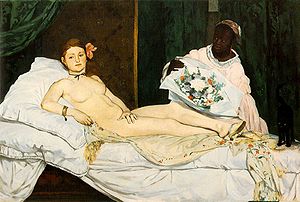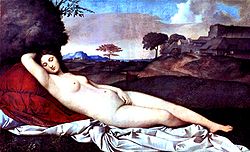- Olympia (Manet)
-
Olympia 
Artist Édouard Manet Year 1863 Type Oil on canvas Dimensions 130.5 cm × 190 cm (51.4 in × 74.8 in) Location Musée d'Orsay, Paris Olympia is an oil on canvas painting by Édouard Manet. Painted in 1863, it measures 130.5 by 190 centimetres (51 x 74.8 in). The nation of France acquired the painting in 1890 with a public subscription organized by Claude Monet. It is now in the Musée d'Orsay, Paris.
Contents
Critical reaction
Though Manet's The Luncheon on the Grass (Le déjeuner sur l'herbe) sparked controversy in 1863, his Olympia stirred an even bigger uproar when it was first exhibited at the 1865 Paris Salon. Conservatives condemned the work as "immoral" and "vulgar." Journalist Antonin Proust later recalled, "If the canvas of the Olympia was not destroyed, it is only because of the precautions that were taken by the administration." However, the work had proponents as well. Émile Zola quickly proclaimed it Manet's "masterpiece" and added, "When other artists correct nature by painting Venus they lie. Manet asked himself why he should lie. Why not tell the truth?"
Precedents
 Sleeping Venus (c. 1510), also known as the Dresden Venus by Giorgione
Sleeping Venus (c. 1510), also known as the Dresden Venus by Giorgione
 La maja desnuda (circa 1797–1800), known in English as The Naked (or Nude) Maja by Francisco de Goya
La maja desnuda (circa 1797–1800), known in English as The Naked (or Nude) Maja by Francisco de Goya
The painting was inspired by Titian's Venus of Urbino, which in turn refers to Giorgione's Sleeping Venus.[1] There is also some similarity to Francisco Goya's La maja desnuda (c. 1800).
There were also pictorial precedents for a nude woman, attended by a black servant, such as Ingres' Odalisque with a Slave (1842), Léon Benouville's Esther with Odalisque (1844) and Charles Jalabert's Odalisque (1842).[2] Comparison is also made to Ingres' La grande Odalisque (1814). Unlike other artists, Manet did not depict a goddess or an odalisque but a high-class prostitute waiting for a client.
Content
What shocked contemporary audiences was not Olympia's nudity, nor even the presence of her fully clothed maid, but her confrontational gaze and a number of details identifying her as a demi-mondaine or courtesan. These include the orchid in her hair, her bracelet, pearl earrings and the oriental shawl on which she lies, symbols of wealth and sensuality. The black ribbon around her neck, in stark contrast with her pale flesh, and her cast-off slipper underline the voluptuous atmosphere. Whereas Titian's Venus delicately covers her vulva, Olympia's hand firmly protects hers, as if to emphasize her independence and sexual dominance over men. Manet replaced the little dog (symbol of fidelity) in Titian's painting with a black cat, which symbolized prostitution. Olympia disdainfully ignores the flowers presented to her by her servant, probably a gift from a client. Some have suggested that she is looking in the direction of the door, as her client barges in unannounced.
The painting deviates from the academic canon in its style, characterized by broad, quick brushstrokes, studio lighting that eliminates mid-tones, large color surfaces and shallow depth. Instead of a smooth idealised nude, as in Alexandre Cabanel's La naissance de Vénus (also painted in 1863), Manet painted a real woman, whose nakedness is revealed in all its brutality by the harsh light.
The model, Victorine Meurent, went on to become an accomplished painter in her own right.
Homage
- "Odalisque I. Looking at Manet. Olympia," and "A Family (painting)," paintings by Louis le Brocquy.
- "Calypso," a 1977 painting by Paul Roberts.
- Spirit of the Dead Watching, an 1892 painting by Paul Gauguin.
References
- Ross King. The Judgment of Paris: The Revolutionary Decade that Gave the World Impressionism. New York: Waller & Company, 2006 ISBN 0-8027-1466-8. See pages 105-108.
- Eunice Lipton. Alias Olympia: A Woman's Search for Manet's Notorious Model & Her Own Desire. Ithaca: Cornell University Press, 1999. ISBN 0-8014-8609-2
- V. R. Main. A Woman With No Clothes On. London: Delancey Press, 2008 ISBN 9-7809-5391-1974.
Notes
External links
- The Shock of the Nude: Manet's Olympia by PBS
- An Eye on Art: Manet's Olympia.
- Phylis A. Floyd, The Puzzle of Olympia
- smARThistory: Olympia
Édouard Manet Paintings The Spanish Singer (1860) · Boy Carrying a Sword (1861) · Music in the Tuileries (1862) · The Old Musician (1862) · The Luncheon on the Grass (1863) · Olympia (1863) · The Fifer (1866) · The Races at Longchamp (1867) · The Balcony (1868) · Execution of Emperor Maximilian (1869) · Effect of Snow on Petit-Montrouge (1870) · The Railway (1873) · The Reading (1873) · Nana (1877) · Self-Portrait with Palette (1879) · A Bar at the Folies-Bergère (1882)
Model Impressionism Originators 
Patrons Dealers Artists in USA Other artists - Lovis Corinth
- Max Liebermann
- Max Slevogt
- Konstantin Korovin
- Valentin Serov
- Francisco Oller
- Laura Muntz Lyall
- Władysław Podkowiński
- Nazmi Ziya Güran
- Chafik Charobim
- Ernest Jean-Marie Millard de Bois Durand
Other media See also Categories:- Édouard Manet paintings
- Collections of the Musée d'Orsay
- 1863 paintings
- Erotic art
Wikimedia Foundation. 2010.

